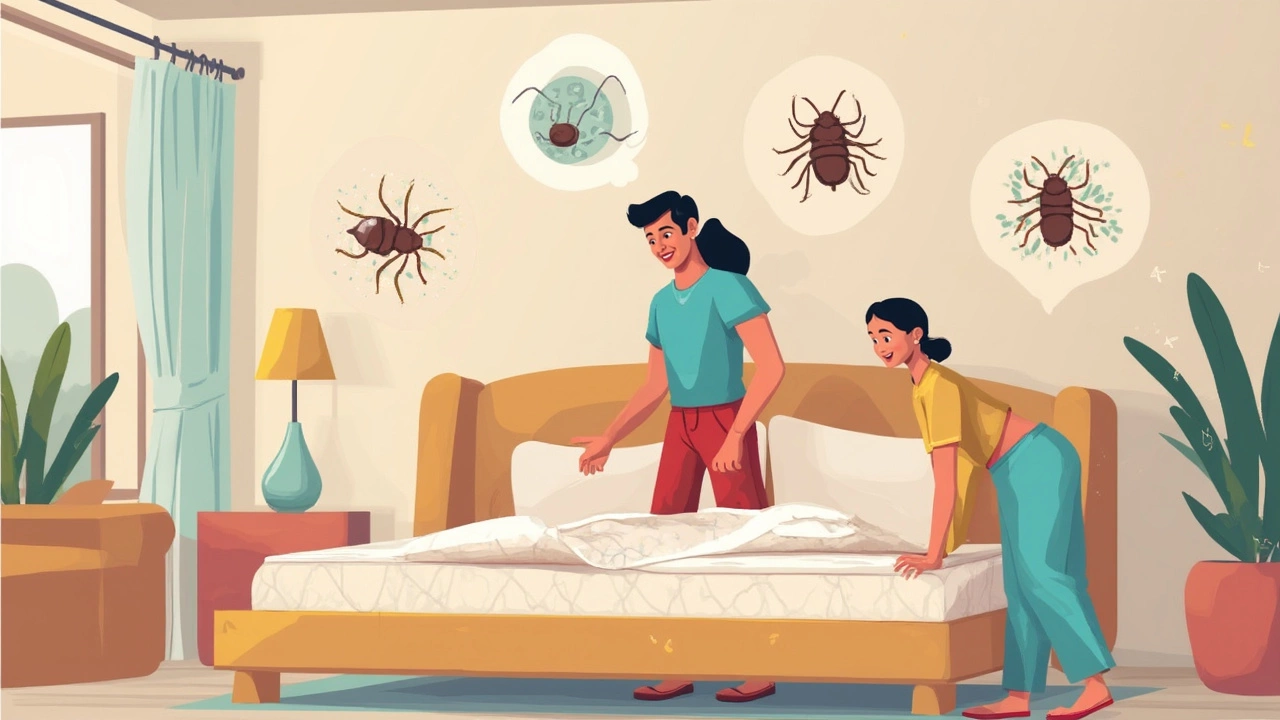How Often Should You Replace Your Bedding? Smart Tips for a Healthier Sleep

Ever peeled back your sheets and wondered what’s really lurking there? Your bed might look spotless at first glance, but even the cleanest beds become a playground for dead skin cells, sweat, and dust mites way faster than you'd guess. If you wake up itchy or stuffy, those old sheets or pillows could be the culprits.
Most people hold onto bedding way longer than is good for them—often until it’s threadbare or starts to smell weird. But did you know the average pillow can double its weight in just a couple of years thanks to a mix of moisture and, well, body gunk? Gross, right? Swapping out your bedding at the right time actually helps you sleep better, wake up clearer, and yes, even cut down allergy flare-ups.
You don’t have to toss everything the minute it looks a little worn, but there’s a sweet spot before things get truly nasty. Let’s get real: clean, fresh bedding isn’t just about comfort. It’s about keeping your sleeping space healthy—and kicking up your quality of rest.
- How Gross Can Bedding Get?
- Sheets: When Is It Time to Let Go?
- Pillows: The Hidden Problem Under Your Head
- Duvets, Comforters, and Blankets: The Big Stuff
- Mattress Lifespan: Don’t Sleep on This
How Gross Can Bedding Get?
Let’s get real: your bed isn’t as squeaky-clean as it looks. The truth is, every night you’re sharing it with things you can’t even see. When it comes to bedding, you’re not just rolling around in covers; you’re cuddling up with sweat, dead skin cells, body oils, and sometimes even those tiny, pesky dust mites. And if you let your pets sleep with you? That’s a whole extra layer of fur and possibly fleas.
Here’s what you’re really sleeping with after just a week on the same sheets:
- About 100,000 to 10 million dust mites (yep, those numbers are real)
- A build-up of sweat—an adult can lose up to half a liter per night
- Dead skin flakes—around 30,000 to 40,000 per minute, which adds up fast overnight
- Fungi and bacteria that love warm, damp bedding
Ever noticed yellow stains on your pillow? That’s mostly from sweat mixing with body oils and saliva. Even if you shower before bed, all that stuff ends up trapped in your sheets and pillows. And honestly, it gets worse the longer you wait to change them.
Need some hard facts? Check these out:
| Gross Factor | Details |
|---|---|
| Dust Mites | Can trigger allergies; found in 4 out of 5 beds tested (National Sleep Foundation) |
| Bacteria | Researchers found more bacteria on week-old pillowcases than a toilet seat |
| Fungi | Some pillows contain up to 16 types of fungi after 1 year |
| Pet Dander | Can last months, even after deep cleaning, if pets sleep on your bed regularly |
This isn’t to freak you out, but a quick look at the numbers shows why swapping your bedding regularly is a no-brainer if you care about your health—even if your sheets smell and look fine on the surface.
Sheets: When Is It Time to Let Go?
You probably change your sheets every week or two, but that doesn’t mean you can use the same set forever. Sheets go through a lot each night: sweat, body oils, dead skin, and crumbs if you ever eat in bed (you’re not alone). Even top-quality sheets eventually get worn out, no matter how well you care for them.
The magic number? Most experts say you should replace your sheets every one to two years. Cotton sheets tend to last longer if you use a gentle detergent and avoid super-hot washes, but even premium brands hit their limit before that third birthday.
Here are some obvious signs it’s time to let go:
- The fabric feels rough or thin, even after washing.
- You notice pilling, tears, or permanent stains that don’t come out.
- Your sheets look faded or yellowed, especially on the pillow area.
- Your bed just doesn’t smell fresh, even when the sheets are newly washed.
Why does it matter? Old sheets are a prime hangout for dust mites—and one study found that after two years, about one third of your pillowcase's weight can be dead skin, dust mite poop, and sweat. That’s a mess you can’t always see.
Check out how long different types usually last:
| Sheet Material | Average Lifespan |
|---|---|
| Cotton (regular) | 1–2 years |
| Egyptian/Organic Cotton | 2–3 years |
| Polyester blend | 1–2 years |
| Linen | 3–5 years |
| Bamboo | 1–2 years |
The best way to stretch the lifespan of your bedding is to have a few different sheet sets and rotate them. Gentle washing, low heat drying, and ditching fabric softeners also help. If you can’t remember when you bought your current sheets, that’s probably your cue to treat yourself to a fresh set soon.

Pillows: The Hidden Problem Under Your Head
If you’re waking up with a stiff neck, headaches, or a stuffy nose, your pillow could be the problem. Most folks keep their pillows for way too long. In reality, you should swap them out every 1-2 years, even if they look okay. Over time, pillows collect sweat, drool, oil from your hair and face, and, yes, dead skin cells. All of that turns your pillow into a perfect hangout spot for dust mites and bacteria.
| Pillow Type | Recommended Replacement |
|---|---|
| Polyester | Every 1-2 years |
| Memory Foam | Every 2-3 years |
| Feather/Down | Every 1-3 years |
| Latex | Every 2-4 years |
According to sleep health experts, a pillow’s weight can double from just absorbing your sweat and flakes of skin. Guess what? A 2022 hygiene study found that after just two years, the inside of the average household pillow contained as much as 16 different kinds of fungus (yikes).
Here are signs you need to toss your pillow:
- It’s lost its shape and won’t fluff up
- Your neck or back hurts in the morning
- It smells funky even after washing
- You see stains or yellowing spots
- You fold it in half and it stays folded
If you have allergies or sensitive skin, think about replacing pillows even sooner. Wash pillow covers every week and use pillow protectors for an extra layer of defense. When you shop for new pillows, check for hypoallergenic options—huge win for allergy sufferers.
Bottom line: fresh pillow replacement keeps you breathing easier and sleeping better. Your head (and nose) will thank you for it.
Duvets, Comforters, and Blankets: The Big Stuff
When’s the last time you really thought about your comforter or blanket? Most people just wash the sheets and forget the bulky stuff, but these layers soak up plenty: sweat, shed skin, pet dander, and the occasional spilled coffee. Ignoring them is like vacuuming without emptying the bin—it works for a while, then starts to backfire.
Here’s the deal: for daily-use blankets, plan on tossing them in the wash every few weeks (monthly is the bare minimum). Comforters and duvets usually hide under covers, so they can go a bit longer—every three to six months is a solid target. But if you have allergies, pets sharing your bed, or you sweat a lot at night, every 1-2 months is smarter.
| Bedding Type | How Often To Wash | How Often To Replace |
|---|---|---|
| Duvets/Comforters | Every 3-6 months | Every 5-10 years |
| Blankets | Every 2-4 weeks | Every 3-5 years |
Replacement is another conversation. A comforter or duvet will last up to ten years if you treat it right—wash it gently, keep it in a cover, and keep pets with sharp claws off it. But once you spot lumps that won’t fluff out, permanent stains, or a strange smell that won’t wash away, it’s time for a new one. Blankets wear out even faster, especially if you machine dry them all the time.
Tip: Always check the wash tag. Some comforters, especially down or fancy synthetic ones, can clump or even shrink with hot water or high heat drying. When in doubt, cold wash and air dry. For allergen control, the bedding should hit at least 130°F in the wash, but protect the fabric from damage by using a gentle cycle.
If you’ve got allergies, a regular wash schedule matters just as much as swapping old stuff for new. All those mites and allergens settle deep inside—and you only get rid of them with thorough washing or by saying goodbye to that heavy old comforter for good.

Mattress Lifespan: Don’t Sleep on This
Mattresses don’t last forever, no matter how good you are at flipping or rotating them. For most people, swapping out their mattress every 7–10 years is the sweet spot for comfort and health. After about a decade, your mattress has sucked up years of sweat, body oils, and all sorts of debris—even if you use a protector. Old mattresses can also sag or lose support, turning your nights restless and leaving you with back aches.
Studies show that a mattress that’s past its prime can actually make allergies worse because of the pile-up of dust mites and dead skin. And saggy mattresses can mess with your posture, leading to neck pain, back pain, or even that annoying numb-feet feeling when you first wake up. If you notice you’re sleeping better at hotels than at home, it might be a sign you’re due for an upgrade.
Here are a few telltale signs your mattress needs to go:
- Lumps, sags, or permanent body indentations
- Waking up with new aches or pains
- Noisy springs (unless you have a foam mattress)
- Increased allergy symptoms at night
- You can see stains, smells, or it just feels "old"
Check out this quick table on the typical lifespan of different mattress types:
| Mattress Type | Lifespan (Years) |
|---|---|
| Innerspring | 6–8 |
| Memory Foam | 8–10 |
| Latex | 10–12 |
| Hybrid | 8–10 |
Want to make your mattress last closer to the upper end of those ranges? Use a reliable mattress protector, wash your sheets weekly, and rotate the mattress every few months. But don’t hang on to an old mattress for nostalgia. A fresh, supportive bed makes a difference for your body and your mood. If you hear creaks, feel sags, or get up more tired than before, it’s time to look for a new one. You spend about a third of your life on that thing. Your health is worth it.
Bottom line: Out of all your bedding, your mattress is the biggest game changer for quality sleep. Don’t underestimate the impact of a replace bedding routine when it comes to your mattress—it’s the foundation for everything else in bed.